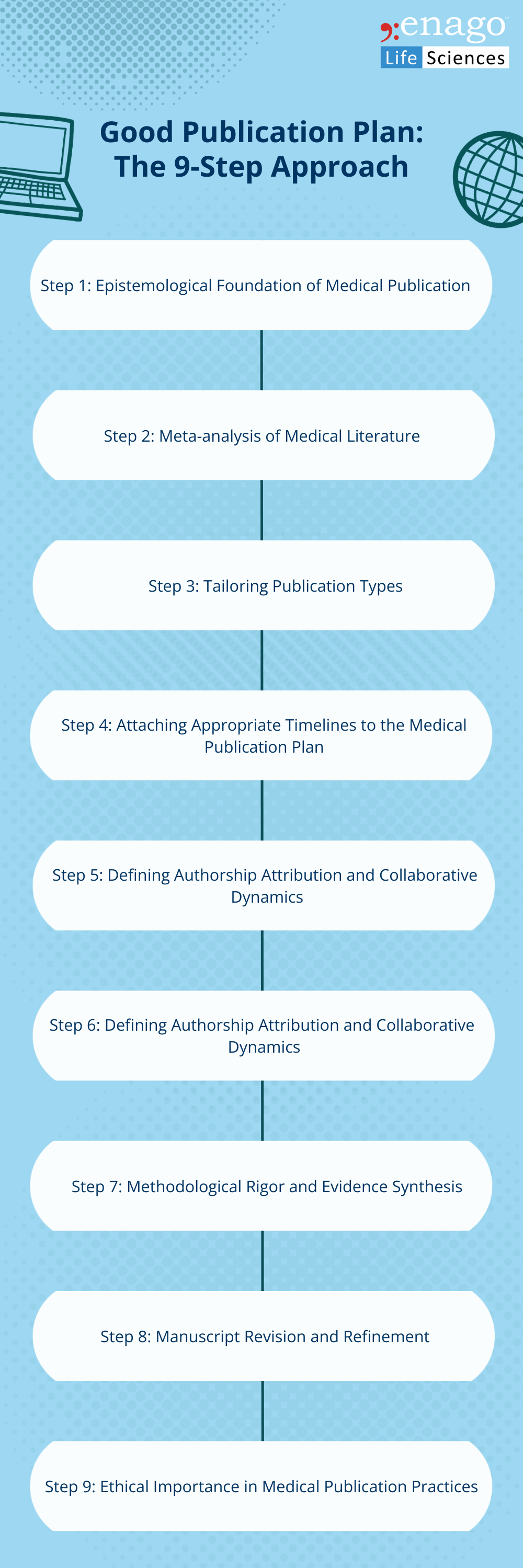The process of publishing pharmaceutical company-sponsored research in medical journals and presenting it at conferences is a complex and strategic endeavor that involves multiple stakeholders and follows a meticulously planned approach. This approach is commonly referred to as a ‘publication plan’. [1]
Significance of Transparent and Well-Structured Publication Plans
Developing a well-structured publication plan involves strategically determining which research findings should be published, where, when and how. A transparent publication plan helps prevent publication bias – the tendency to publish only positive results – and ensures that all research outcomes, whether positive or negative, are reported.[2] This prevents incomplete or skewed representations of scientific knowledge, enabling a more accurate assessment of interventions, treatments, or procedures.
What Makes a Good Publication Plan: A Comprehensive Step-by-Step Approach
Step 1: Epistemological Foundation of Medical Publication
The epistemological approach in medical publishing deals with how medical knowledge is created, validated, and communicated. It ensures reliable and credible information by validating knowledge and upholding scientific methodologies, like empirical observation and peer review.
- Paradigm Shifts and Their Impact: Changes in theories, methodologies, and perspectives influence the trends in research dissemination.[3] For instance, the transition from a reductionist to a systems biology approach has reshaped the scope and objectives of medical publications, promoting a more holistic understanding of diseases and interventions.[4]
- Philosophical Considerations Shaping Knowledge Dissemination: Philosophical stances, such as positivism, constructivism, and critical theory, subtly shape how medical research is presented.[5] Researchers must navigate these epistemological choices when framing their work for publication, as different philosophical lenses influence the framing of research questions, interpretation of findings, and the presentation of evidence.
- Aligning Research Goals With Pragmatic Objectives: In medical publication, aligning research goals with pragmatic objectives ensures that the dissemination of findings is relevant and impactful. Researchers must weigh the theoretical significance of their work against its potential to drive practical improvements in patient care and medical practice.[2]
- Balancing Exploratory and Hypothesis-Driven Publications: Medical research often balances between exploratory studies that generate hypotheses and hypothesis-driven studies that test specific questions.[6] Effective medical publication planning acknowledges this balance, as both types of studies contribute to the broader understanding of medical phenomena.
Step 2: Meta-analysis of Medical Literature
- Exploring and Mapping Global Medical Research: Strategic selection of platforms ensures the target audience is reached while adhering to the scope and objectives of the research. Furthermore, understanding the collaborative network in medical research is essential. Collaborations often transcend borders and disciplines, impacting the dissemination strategy.
- Knowledge Synthesis and Gap Identification: Before publishing, researchers need to examine existing studies to find gaps in current knowledge. This examination helps form research questions and puts the study in context.[7] Closing these gaps affects how valuable the publication is, stressing its significance and assisting in choosing the type of publication.
Step 3: Tailoring Publication Types
- Clinical Trials, Systematic Reviews, Case Studies, and Meta-analyses: Different publication types serve distinct purposes, from presenting original research (clinical trials) to synthesizing existing evidence (systematic reviews, meta-analyses) or reporting unique cases (case studies). Moreover, the research’s depth can also influences the type of publication. A comprehensive study might necessitate a systematic review, while a focused investigation might warrant a case study. Selection of the appropriate manuscript type should align with the research’s objectives, type of methodology and significance of contributions.
- Strategic Selection of Publication Type: It’s important to justify the publication type choice. Researchers must ensure that the chosen publication type effectively showcases the research’s methodology, findings, and implications.
Step 4: Attaching Appropriate Timelines to the Medical Publication Plan
- Sequencing Publications to Present a Coherent Narrative: For multi-phase studies, publications should be sequenced to create a narrative that builds upon previous findings. This approach enhances the reader’s understanding of the research’s evolution and impact. Additionally, longitudinal studies demand careful planning to ensure findings are disseminated effectively as the research progresses.[8] This requires coordination of publication timelines with data collection and analysis milestones.
- Defined Strategies for Rapid Communications vs. Comprehensive Disclosures: Quick-sharing formats like preprints enable rapid dissemination of initial findings, while in-depth publications offer detailed analysis. Balancing these approaches addresses the need for both urgency and rigor. Incorporating interim results into future publications strategically enhances research impact and preserves findings’ integrity through an iterative process.
Step 5: Defining Authorship Attribution and Collaborative Dynamics
- Ethical Considerations in Determining Authorship: Deciding on authorship entails ethical considerations and compliance with guidelines from bodies like the International Committee of Medical Journal Editors (ICMJE).[9] Authorship should signify meaningful contributions and remain unaffected by hierarchical dynamics. Well-defined roles, coupled with transparent medical communication, guarantee proper recognition of contributors.
- Navigating Inter-institutional, Multidisciplinary Collaborations: Collaborations increase research quality but may also introduce challenges in communication and decision-making. Skilful collaboration management ensures cohesive intellectual teamwork across different institutions and fields. Hence, open discussions about credit distribution cultivate collaboration and uphold ethical norms.[10]
Step 6: Structuring Different Medical Publications
- Crafting Cohesive Narratives in Various Publication Types: The manuscript’s organization differs with its type and should stay logical. A good structure leads readers through context, method, results, and implications.
- Precise Interpretation of Data: Data presentation should align with the selected publication type while providing sufficient context for interpretation. Clear visualization and accurate statistical representation enhance data-driven communication.
Step 7: Methodological Rigor and Evidence Synthesis
- Rigorous Study Design, Statistical Analysis, and Data Validation: Methodological integrity supports the research’s validity and credibility.[11] Transparently detailing study design, statistical methods, and data validation enhances the publication’s rigor.
- Converging Diverse Evidence Sources to Strengthen Conclusions: Synthesizing evidence from various sources, such as clinical trials and real-world data, strengthens the research’s validity. Triangulating evidence mitigates bias and enhances the robustness of conclusions.
Step 8: Manuscript Revision and Refinement
- Seeking Feedback for Manuscript Improvement: Peer review and constructive feedback are integral to refining manuscripts. Embracing iterative cycles of revision ensures that the manuscript evolves and matures over time. Each revision cycle addresses different aspects, from content clarity to structural coherence.
- Engaging Constructively with Peer Reviewers’ Critiques: Responding to reviewers’ comments requires open-mindedness and resilience. Addressing critiques thoughtfully, whether through additional experiments or revised explanations, enhances the manuscript’s scientific rigor. View criticism as an opportunity for growth to cultivate intellectual resilience.
Step 9: Ethical Importance in Medical Publication Practices
- Upholding Ethical Standards in Reporting Sensitive Medical Research: Ethical considerations are crucial in research involving vulnerable populations or sensitive topics. Research involving populations such as minors, the elderly, or those with cognitive impairments, requires an added layer of vigilance.[12] Such groups are more susceptible to coercion or undue influence, making it imperative to establish stringent safeguards to protect their rights, well-being, and autonomy. Informed consent, for instance, becomes not only a procedural necessity but a moral obligation, ensuring that these individuals comprehend the research’s purpose, procedures, and potential risks, and provide their voluntary agreement to participate.
- Transparent Reporting of Methods, Data, and Funding Sources: Complete and accurate reporting ensures research reproducibility and credibility. Detailed methods, data availability, and funding disclosures allow readers to assess the research’s validity.[13] Openly disclosing potential biases and conflicts reduces their impact. Thus, transparent intentions emphasize the research’s credibility and commitment to unbiased reporting.
To conclude, strategizing a medical publication plan is a complex process that involves careful and important decision-making. These plans help make sure that research results are shown without any bias, whether they’re good or not. This step-by-step guide explains how to ensure good publication practices in when reporting and disseminating medical research. Following these steps will help researchers share findings in an open manner, making sure it’s accurate and useful for improving healthcare.
References
1- Sismondo, Sergio, and Scott Howard Nicholson. “Publication Planning 101.” Journal of Pharmacy & Pharmaceutical Sciences, vol. 12, no. 3, 3 Oct. 2009, p. 273, https://doi.org/10.18433/j3ww2r. Accessed 8 Oct. 2020.
2- Nair, AbhijitS. 2019. “Publication Bias – Importance of Studies with Negative Results!” Indian Journal of Anaesthesia 63 (6): 505. https://doi.org/10.4103/ija.ija_142_19.
3- Ashcroft, R E. 2004. “Current Epistemological Problems in Evidence Based Medicine.” Journal of Medical Ethics 30 (2): 131–35. https://doi.org/10.1136/jme.2003.007039.
4- Rocca, Elena, and Rani Lill Anjum. 2020. “Complexity, Reductionism and the Biomedical Model.” Rethinking Causality, Complexity and Evidence for the Unique Patient 1 (1): 75–94. https://doi.org/10.1007/978-3-030-41239-5_5.
5- Saunders, Mark & Lewis, P. & Thornhill, A.. (2009). Understanding research philosophies and approaches. Research Methods for Business Students. 4. 106-135
6- Sacristán, José A. 2011. “Exploratory Trials, Confirmatory Observations: A New Reasoning Model in the Era of Patient-Centered Medicine.” BMC Medical Research Methodology 11 (1). https://doi.org/10.1186/1471-2288-11-57.
7- Snyder, Hannah. 2019. “Literature Review as a Research Methodology: An Overview and Guidelines.” Journal of Business Research 104 (1): 333–39. https://doi.org/10.1016/j.jbusres.2019.07.039.
8- Caruana, Edward, Marius Roman, Jules Hernández-Sánchez, and Piergiorgio Solli. 2015. “Longitudinal Studies.” Journal of Thoracic Disease 7 (11): 537–40. https://doi.org/10.3978/j.issn.2072-1439.2015.10.63.
9- International Committee of Medical Journal Editors. 2023. “ICMJE | Recommendations | Defining the Role of Authors and Contributors.” Www.icmje.org. 2023. https://www.icmje.org/recommendations/browse/roles-and-responsibilities/defining-the-role-of-authors-and-contributors.html.
10- Bornmann, Lutz, and António José Osório. 2019. “The Value and Credits of N-Authors Publications” 13 (2): 540–54. https://doi.org/10.1016/j.joi.2019.03.001.
11- 2023. Apa.org. 2023. https://www.apa.org/pubs/journals/features/cou-cou0000523.pdf.
12- University of Oxford. 2021. “Informed Consent | Research Support.” University of Oxford. 2021. https://researchsupport.admin.ox.ac.uk/governance/ethics/resources/consent.
13- “Reporting Standards and Availability of Data, Materials, Code and Protocols | Nature Portfolio.” n.d. Www.nature.com. https://www.nature.com/nature-portfolio/editorial-policies/reporting-standards.
Author:

Uttkarsha Bhosale
Editor, Enago Academy
Medical Writer, Enago Life Sciences
Connect with Uttkarsha on LinkedIn



Wow, amazing weblog format!
The whole look of your site is fantastic, let alone the content!